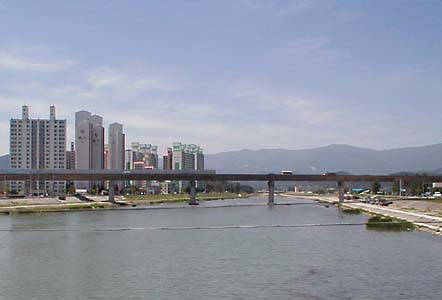
The mountains near Seoul are nearly invisible ...

And smog, though much lighter, still affects the view in Kangnung (Gangneung).
(Please read
this
before you copy our photos or text.)
|
Seoul has the dubious distinction of being one of the world's most polluted cities.
The top photo, which I shot from my hotel window in May 2000, says it all. Korea's government placed industrial development above just about everything else in the 1970s and 1980s. Apparently administrators don't breathe, or else they just didn't notice how bad the air was getting. It wasn't until the 1990s that the government finally passed laws clamping down on industrial emissions. Now it's China's turn. They're upwind from Korea and they contribute at least as much sulfur oxide to South Korea's air as Korea's own industries. China's gift to Korea (and in fact to all of Asia) is thus not just smog, but acid rain and polluted lakes. It gets better: every spring, China also sends along the yellow dust from her deserts. Fortunately, the yellow dust only lasts a few weeks. Internally, Korea's biggest air pollution source is -- just as in most developed countries -- vehicles. Diesel buses and trucks amount to only 4% of Korea's vehicle population, but they belch out 40% of the total vehicle emissions. Fifteen or 20 years ago, Korea's predominant odor was sewage. Improved drainage has taken care of most of that, but now the big cities stink of diesel exhaust. It's not just commercial trucks and buses. Private vehicle ownership has really jumped in Korea. It's up an astonishing 1,600 percent since 1980, and far too many of these are diesels. How did this happen? For many years, Korean law limited diesel engines to larger vehicles. When those laws were passed, Koreans were poorer than they are now. They could only afford tiny cars (if that). But things have changed. Today,
You'd think they'd change the fuel tax structures to discourage this sort of thing. And in fact in the 1990s, the government offered incentives (including lower fuel taxes) for running cars on LP gas, which is one of the cleaner vehicle fuels available. But then they restricted LP gas to certain kinds of vehicles (including large ones), presumably in order to keep tax revenues up. You can guess what happened next. Just as with diesel, the automakers built larger vehicles so they could use LP gas. Of course they burn more fuel, but the fuel is cheaper. Now carbon emissions are up, fuel imports are increasing, and the streets and parking lots are choked with both diesel fumes and big SUVs. How much all this weaving and dodging has harmed Korea's air quality is hard to say, but I do know that Korea's carbon emissions (and energy use) doubled in the early to mid 1990s. And although the Korean government claims to be concerned, they don't seem concerned enough to implement really aggressive antipollution measures. On top of the '90s jump, Korea expects energy use to increase 3.2 percent per year through 2020. Although 40% of Korea's electricity now comes from nuclear reactors, and they plan to build more of them, they also say they're probably going to burn more coal. It looks like Korea has an uphill climb to cleaner air. So what does this mean to you? If you have respiratory problems, I'd say you'd be smart to avoid big cities. Definitely stay away from Seoul. Ulsan is home to some heavy industry and I hate to think what kind of chemicals those factories dump into the air, soil, and water. I suppose I'm biased because Kangnung (Gangneung) is where Margaret lived and worked, but it's still documented fact that Kangwon (Gangwon) Province and Kangnung have Korea's cleanest air. "Korea's cleanest air" doesn't mean pristine (see photo above). I don't have the figures, but I'm guess from the way it looks that Kangnung's air quality is similar to that in a comparable midwestern US city. Our Kangnung friends also tell us that the Namdaechon River (above) is pretty heavily polluted, though I've never found anything in writing that admits it. For all that, Kangnung's air can't be that bad. Margaret actually had clearer sinuses there than she usually does here in the States. Sources:
|